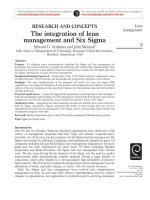The architecture of computer hardware and systems software an information technology approach ch12
Bạn đang xem bản rút gọn của tài liệu. Xem và tải ngay bản đầy đủ của tài liệu tại đây (1.75 MB, 40 trang )
Chapter 12
Three System Examples
The Architecture of Computer Hardware
and Systems Software:
An Information Technology Approach
3rd Edition, Irv Englander
John Wiley and Sons
2003
Three System Examples
X86 Family
PowerPC
IBM System 360/370/390/zSeries
Family
Chapter 12
12-2
The X86 Family
System Overview
The CPU
Registers
Instruction Set
Addressing Modes
Advanced Design Features
CPU Organization
The IA-64 Itanium Architecture
Chapter 12
12-3
System Overview
Bus-oriented system I/O
Nonmaskable interrupts
Emergency situations
Single maskable interrupt
Supports 32 prioritized interrupts
IRQ0 to IRQ31
Upon receiving an interrupt, the CPU
reads an address on the data lines that
is used to jump to the interrupt routine
Chapter 12
12-4
The CPU
Downward software compatibility
Disabled protected mode
Compatible with the original 8088 architecture
Original Intel 8088 CPU
16-bit processing and registers
16-bit internal data bus
8-bit external data bus
20-bit memory addressing – 1Mbyte total
Current Pentium CPUs
256-bit internal data bus
64-bit external data bus
2 levels of memory caching
Added floating point, multimedia, virtual storage, and multitasking
support
Chapter 12
12-5
Registers
8088, 8086, 80286
8 general-purpose registers
4 segment registers
1 flag register
Instruction pointer, and various control registers
80386 – added 2 segment registers
80486
8 80-bit floating point registers
Various floating point control registers
Pentium MMX
added registers for multimedia support
Pentium III
8 128-bit SIMD registers and control register
Chapter 12
12-6
General Purpose Registers
Chapter 12
12-7
Instruction Set and Format
Data transfer
Integer arithmetic
Branch
Bit manipulation, rotate and
shift
String manipulation
Chapter 12
Input / Output
Flag
Instructions added in later
processors
Floating point
MMX
SIMD
12-8
Chapter 12
12-9
Addressing Modes
Register
Immediate
Direct Addressing
Register Deferred Addressing
Base Addressing
Indexed Addressing
Base Indexed Addressing
Chapter 12
12-10
Real Mode vs. Protected Mode
Real Mode
Protected Mode
Chapter 12
12-11
Advanced Design Features
Protected Mode
Virtual storage support
Memory management
Multitasking support through efficient task
switching
Virtual 8086 Mode
Can only be used when protected mode is
activated
Calculates addresses the same way as real mode
Allows the system to run several 8086 tasks at
once
Chapter 12
12-12
X86 Protection Levels
Chapter 12
12-13
CPU Organization
Early processors
Pipelined instruction fetch unit
Single integer execution unit
Current processors
Modern superscalar, pipelined design
Instruction decoder creates an intermediate set of
micro-operations, μops
μops translate variable length and complex
instructions into a 3-operand fixed length format
Chapter 12
12-14
IA-64 Itanium Architecture
EPIC Architecture
Incorporates entire X86 instruction set and memory
model
128 65-bit registers for programs
128 80-bit floating point registers
8 64-bit branch registers
64 1-bit predicate registers
Instead of instruction reordering, speculation and
predication is used for branch predictions
IA-64 Mode
64-bit logical addresses
63-bit physical addresses
Chapter 12
12-15
The PowerPC
System Overview
The CPU
Registers
Instruction Set
Addressing Modes
Advanced Design Features
CPU Organization
Chapter 12
12-16
System Overview
Developed by Apple, Motorola, and IBM
Bus-oriented I/O architecture that can
be interfaced with standard buses of
other personal computers
Permits system components, bus
adapters, and devices developed for
other computers to be used with the
PowerPC processor
Prioritized multi-level internal interrupts
Chapter 12
12-17
The CPU
RISC design
32-bit implementation
32-bit registers and addressing
Up to 36-bit physical and 52-bit virtual addresses
64-bit implementation
64-bit registers and addressing
Superscalar design
Only 40 bits of interface to physical storage
Can run programs written for the 32-bit implementation
Supports floating point calculations, memory caching, and
virtual memory
More current implementations also support vector processing
Chapter 12
12-18
PowerPC Processor
Characteristics
Chapter 12
12-19
Registers
32 general purpose registers
32 floating point registers
Link register
Count register
Condition register
Fixed and floating point status registers
7400 processor series
32 128-bit vector processing registers
2 vector control registers
Chapter 12
12-20
PowerPC User Registers
Chapter 12
12-21
Instruction Set
Integer
Floating point
Load / Store
Flow Control
Processor Control
Memory Control
15 Different instruction formats
No specifically designed I/O instructions
because PowerPC uses memory mapped I/O
Chapter 12
12-22
Typical Instruction Formats
Chapter 12
12-23
Addressing Modes
Chapter 12
12-24
Address Translation Mechanisms
Chapter 12
12-25









